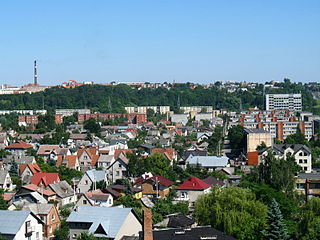
The Neris or Viliya is a river rising in Belorussia. It flows through Vilnius (Lithuania) and becomes a tributary of the Neman River (Nemunas) at Kaunas (Lithuania). Its length is 510 km (320 mi).

Gediminas Avenue is the main street of Vilnius, where most of the governmental institutions of Lithuania are concentrated, including the government, parliament, Constitutional Court and ministries. It is also the place of cultural institutions such as Lithuanian National Drama Theatre, Bank of Lithuania, Lithuanian Academy of Music and Theatre and Martynas Mažvydas National Library Nowadays it is also a popular shopping and dining street. It is partially a pedestrian street in the evenings when the traffic is prohibited.

The June Uprising was a brief period in the history of Lithuania between the first Soviet occupation and the Nazi occupation in late June 1941. Approximately one year earlier, on June 15, 1940, the Red Army invaded Lithuania and the unpopular Lithuanian Soviet Socialist Republic was soon established. Political repression and terror were used to silence its critics and suppress any resistance. When Nazi Germany attacked the Soviet Union on June 22, 1941, a diverse segment of the Lithuanian population rose up against the Soviet regime, declared renewed independence, and formed the short-lived Provisional Government. Two large Lithuanian cities, Kaunas and Vilnius, fell into the hands of the rebels before the arrival of the Wehrmacht. Within a week, the German Army took control of the whole of Lithuania. The Lithuanians greeted the Germans as liberators from the repressive Soviet rule and hoped that the Germans would re-establish their independence or at least allow some degree of autonomy. No such support came from the Nazis, who steadily replaced Lithuanian institutions with their own administration. The Reichskommissariat Ostland was established at the end of July 1941. Deprived of any real power, the Provisional Government disbanded itself on August 5.

The Kovno ghetto was a ghetto established by Nazi Germany to hold the Lithuanian Jews of Kaunas during the Holocaust. At its peak, the Ghetto held 29,000 people, most of whom were later sent to concentration and extermination camps, or were shot at the Ninth Fort. About 500 Jews escaped from work details and directly from the Ghetto, and joined Soviet partisan forces in the distant forests of southeast Lithuania and Belarus.

Pasvalys is a city in Panevėžys County, Lithuania, located near the bank of the Svalia River. Its sister city is Götene in Sweden.

Aleksotas is an elderate in the southern section of the city of Kaunas, Lithuania, bordering the left bank of the Nemunas River. Its population in 2006 was 21,694. The borough borders Vilijampolė and Centras in the north, Šančiai and Panemunė in the east, Garliava in the south as well as Akademija in the west.

Centras is an elderate in the city of Kaunas, Lithuania, based on two neighbourhoods of Kaunas - the Old City and the New City. It lies at the confluence of two major Lithuanian rivers, the Nemunas and the Neris. The borough borders Žaliakalnis in the north, Šančiai in the east, Aleksotas in the south and Vilijampolė in the west.
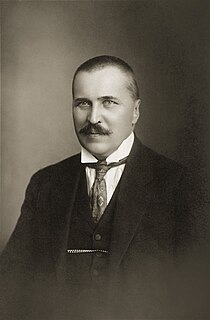
Jonas Vileišispronunciation (help·info)(January 3, 1872 – June 1, 1942) was a Lithuanian lawyer, politician, and diplomat.
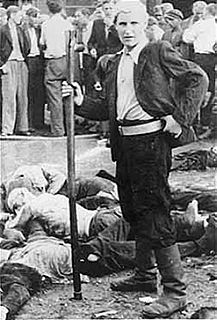
The Kaunas pogrom was a massacre of Jewish people living in Kaunas, Lithuania that took place on June 25–29, 1941 – the first days of the Operation Barbarossa and of Nazi occupation of Lithuania. The most infamous incident occurred in the Lietūkis garage, where several dozen Jewish men were publicly tortured and executed on June 27, most of them killed by a single club-wielding assailant nicknamed the "Death Dealer." After June, systematic executions took place at various forts of the Kaunas Fortress, especially the Seventh and Ninth Fort.
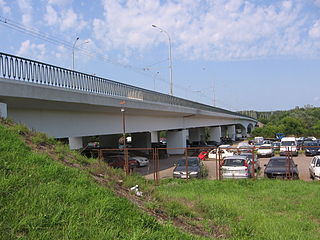
Valakampiai Bridge also known as Valakupiai Bridge is a bridge across Neris River, that connects Žirmūnai and Antakalnis districts of Vilnius. Built in 1972. As of 2007, it is the longest bridge in Vilnius, 341.5 metres long and approximately 21.0 metres wide. The bridge has six spans: the major one, 100.0 metres long is over the river, the second one is on the left bank and four-span viaduct is on the right bank. It is made of ferroconcrete blocks, connected by wire fibers into inseparable ferroconcrete beams.

The signatories of the Act of Independence of Lithuania were the twenty Lithuanian men who signed the Act of Independence of Lithuania on February 16, 1918. The signatories were elected to the Council of Lithuania by the Vilnius Conference in September 1917 and entrusted with the mission of establishing an independent Lithuanian state. The proclaimed independence was established only in late 1918, after Germany lost World War I and its troops retreated from Lithuanian territory. What followed was a long process of building the state, determining its borders, and gaining international diplomatic recognition. The signatories succeeded in their mission and independent Lithuania survived until the Soviet Union occupied the state on June 15, 1940.

Vileišis Palace is a Neo-baroque style architectural ensemble in Vilnius, Lithuania, built for Petras Vileišis. Vileišis was a prominent Lithuanian engineer, political activist, publisher, and philanthropist who commissioned the palace in 1904 and supervised its construction. The ensemble consists of a main house, a guesthouse, and an outbuilding. It currently houses the Institute of Lithuanian Literature and Folklore. It was renovated during the early 2000s.

The Mindaugas Bridge is a bridge in Vilnius, Lithuania. It crosses Neris River and connects Žirmūnai elderate with the Old Town of Vilnius. The bridge was named after Mindaugas, King of Lithuania, and was opened in 2003 during the celebrations of the 750th anniversary of Mindaugas' coronation. The bridge is 101 metres (331 ft) in length and 19.7 metres (65 ft) in width.
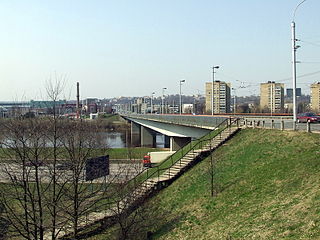
Varnių Bridge is a bridge across the Neris River, that connects Vilijampolė and Žaliakalnis districts of Kaunas, Lithuania. It was built in 1983. The bridge is 328 meters long and approximately 25 meters wide. It carries six lanes of automobile traffic, with three lanes in each direction. Before World War II, neighbourhoods of Vilijampolė and Žaliakalnis were connected by temporary Eiguliai bridge.
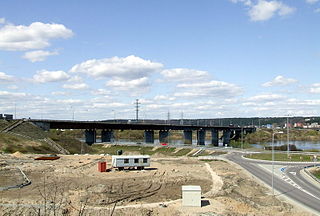
Lampėdžiai Bridge is a bridge in Kaunas, Lithuania. It crosses the Nemunas River to connect Marvelė in Aleksotas district and Lampėdžiai neighbourhood in Vilijampolė elderate. The bridge is 446 metres in length. It carries four lanes of automobile traffic, with two lanes in each direction. The bridge, completed in 1997, is also named after a Lithuanian roadman Česlovas Radzinauskas. Lampėdžiai Bridge is a part of Via Baltica and A5 highway of Lithuania, and western bypass of Kaunas.

The Lithuanian Confederation of Industrialists or LPK is a major association and lobby group in Lithuania which represents the interests of large industrialists and employers. The Confederation in an umbrella organization uniting 44 trade and 9 regional associations which comprise over 2700 medium and large enterprises from various public and private sectors. Confederation membership is entirely voluntary. LPK members cover all the main sectors of industry and unite over a third of the Lithuanian work force, which generates almost 60% of Lithuanian GNP.

Jonava railway bridge is a railway bridge over the Neris in Jonava, the ninth largest city in Lithuania with a population of ca 35,000.
Vilija was a manufacturing company based in Vilnius. It was established in 1911 and produced agricultural iron tools such as ploughs and harrows. It was the first larger enterprise established in Vilnius by Lithuanians. The factory permanently ceased operations in July 1920.


